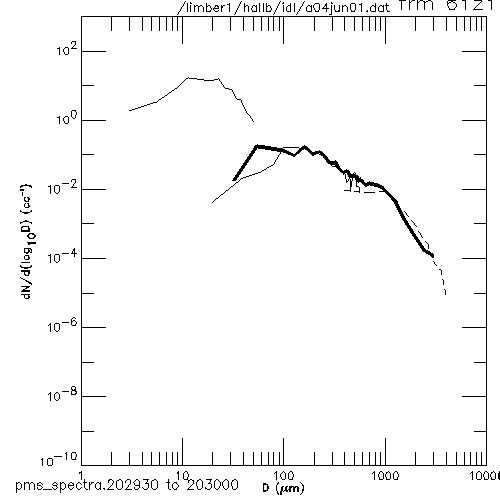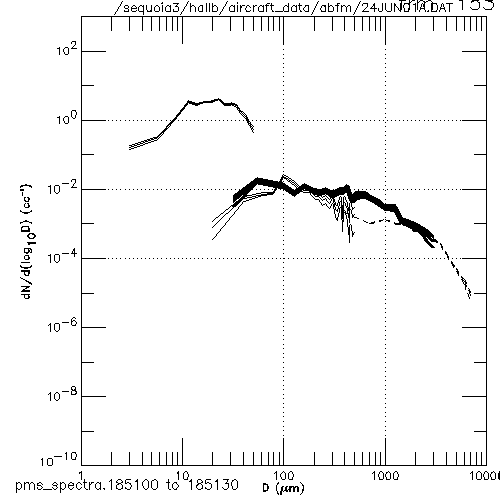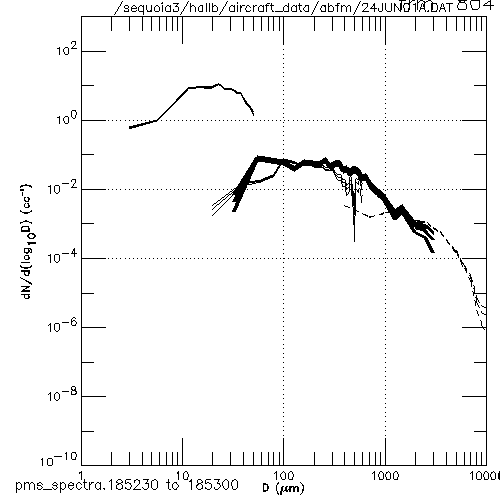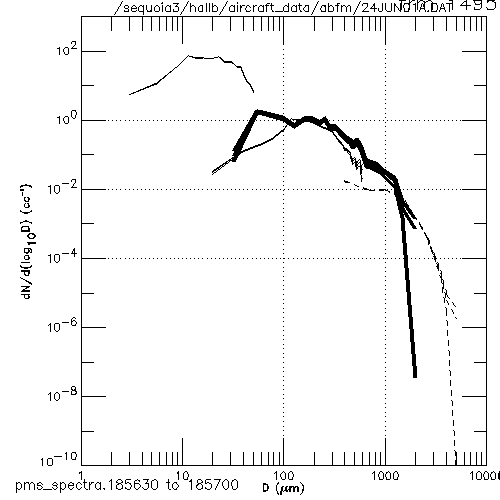BRIEF DESCRIPTION OF THE MICROPHYSICAL INSTRUMENTS USED FOR ABFM
J. Dye
October 7, 2002
A number of different probes were used to measure particles during
the ABFM project. The following is a very brief overview of the
different instruments, how they performed in general and some issues
to consider when examining the time series plots of particle
concentrations which exist on the NCAR ABFM Web Site.
The instruments used were:
1) PMS Forward Scattering Spectrometer Probe (FSSP)
Nominal range 3 to ~50 microns in 15 bins
The FSSP sizes and counts particles by measuring light scatter in the
forward direction. The voltage pulses produced are sized and sorted
into 15 bins in a pulse height analyzer. The instrument was designed to
count and size cloud droplets which are spherical and water. In recent
years some researchers believe that the FSSP output gives a reasonable
idea of total concentration in clouds wholly composed of ice, but not
mixed phase. We include the total concentration from the FSSP as a
measure of the smallest ice in the cloud. Uncertainty in the total
concentration measurement is unknown, but could be a factor of two or
perhaps more. Paul Field has recently shown that artifacts can be
produced by breakup of ice particles colliding on the tips of the FSSP,
but estimated that the uncertainty is probably less than a factor of
two.
ISSUES: The FSSP often has noise in the first bin or two, because the
threshold for the first bin is set close to the signal noise level
(which can be variable in different conditions). Hence out
of cloud you might see some response from the FSSP even though the
2D shows nothing. I have seen this for a couple of days in 2000 and in
2001.
Additionally, during the early part of the May/June 2001 campaign there
was an intermittent power supply that sometimes functioned and
sometimes not.
For more detailed description of the FSSP go to:
fssp100.html
2) Particle Measuring Systems (PMS) 2D-Cloud Probe (2D-C)
Range 33 um to ~1 mm on the UND Citation
The 2D-C produces shadows of particles passing through a collimated
laser beam by recording the time sequence of diodes of a 32 element
diode array which are shadowed by passage of the particle. By scanning
the array at a speed propotional to the aircraft true airspeed, an
image of each particle is generated. The sample volume is size and true
airspeed dependent, and must be accounted for in processing.
Substantial processing must occur to determine concentrations and size
distributions. The probe has 2 buffers which allows one buffer to
collect data, while the previously filled buffer is downloaded. On the
UND system 4 buffers/sec can be recorded.
ISSUES: In both 2000 and 2001 there were some power supply problems,
meaning loss of data. Frequently every other buffer is difficult to
read and sometimes lost. This was particularly true in June 2001 for
all flight days after the lightning strike on 10 June 2001. On occasion
when the Citation was in strong E fields the probe tips apparently go
into corona. When this happens artifacts are generated and the timing
words which are essential for interpreting the data record are
corrupted. The data can not be recovered for those periods. These
artifacts were fairly common during flights in which high fields were
encountered, but did not always happen when the fields were strong.
Undersampling of particles in the lower range of the 2D probe is well
known. It is a result of poor electronic time response and probability
of detection when particles are near or only a little larger than the
size of the elements of the diode array. Concentrations of particles
for sizes less than ~100 microns are underestimated and sometimes this
portion of the size distribution is not included in size distributions.
We have included them for completeness, but the absolute concentrations
should not be trusted.
For further description of operation of the 2D probe go to:
2d Probes
For samples of 2D particle images for each flight day of the June 2000 or May/June 2001
campaign go to:
2D samples
Select the year of interest, 2000 or 2001, and then the flight day. This brings up a list of images from that flight. One out of every 100 buffers recorded by the 2D is shown.
3) PMS 1D-Cloud Probe (1D-C)
Range ~20 to 600 microns
The 1D probe, like the 2D probe, has a 32 element diode array. But
instead of scanning the array and recording occulted diodes, the 1D
electronics determines the maximum number of diodes occulted by each
particle. This information is sorted and counted into different size
bins of a pulse heightt analyser. The first and last diode are used to
determine if a particle is wholly in the beam. Thus functionally only
30 diodes are used for sizing. Particle size distribution are recorded
but without images of the particles.
ISSUES: We only recently started processing the 1D data, so we are not
fully aware of any issues. Like the FSSP, there can be noise in the
first couple of size bins, but so far I have not noticed this in the
ABFM measurements. My impression is that for the ABFM project, the 1D
probe may be the most reliable indicator of when the aircraft enters
and leaves cloud. Like the 2D, under sampling of particles in the
lower range of the 1D probe is well known. It is a result of poor
electronic time response and probability of detection.
For more information on principles of operation of the 1D probe go to:
1D Probe
The above description is for a probe with a 60 element array whereas
the Citation probe has only 32 elements.
4) King Liquid Water Sensor
The King liquid water probe maintains a wire element at a constant
temperature and senses the power necessary to keep the element
at a constant temperature. Because heat loss occurs in clear air
as well as cloud, a "dry" term correction must be made.
ISSUES:
Measurements by others in clouds containing only ice particles (no liquid particles)
have shown that this sensor
does respond fractionally to ice as well as water. Thus, it's
measurements should not be used as a measure of the supercooled liquid
water in our anvil clouds.
For more information on this instrument go to:
King LWC
5) Rosemount Ice Detector
This sensor is a small cylinder of a couple centimeters length and a
few millimeters diameter which when in supercooled water becomes iced.
A magnetostriction circuit determines the change in resonant frequency
of the cylinder and the signal output is proportional to accumulated
ice mass. When a preset threshold is reached the cylinder is heated to
remove any accumulated ice and a new icing cycle is begun. This is the
best measure we have for the possible presence of supercooled water in
ABFM anvils.
ISSUES:
At times spikes are observed in the signal. These are perhaps due to
graupel or other large ice particles impacting on the cylinder.
For more information on this instrument go to:
Ice Probe
6) SPEC Cloud Particle Imager (CPI)
This is a relatively new instrument which in the hot, humid Florida
environment required a lot of attention. When operating properly
it produces spectacular images of ice particles and water drops.
The CPI uses two crossed continuous laser diodes to sense when
a particle is in the intersection of the two beams. Then a 30 mW
laser diode is pulsed at ~20 nanosec to capture the image of the
particle (and any others in the path) on a 1024 x 1022 CCD array.
Each element of the array is ~2.5 microns, so particles in focus
show great detail including particle habit and any evidence of
riming.
ISSUES:
The sample volume of the CPI is small, roughly 2.5 x 2.5 mm square.
Thus it captures images primarily in the range of ~20 microns
to a few hundred microns, because the probability of triggering on
larger ones is so small. Additonally this instrument is sufficiently
new that so far we are not able to determine concentration
independent of other measurements. Also processing and analysis of
the data are extremely time consuming. For ABFM we are using the
measurements primarily for the images and information on particle
types encountered during selected flights.
For more information on the CPI go to:
CPI
7) SPEC High Volume Precipitation Spectrometer (HVPS)
This probe was designed to greatly increase the sample volume for
larger particles. It's operation is somewhat similar to that of the 2D
but is much more complex. It uses two linear arrays of 256 elements each
with each element corresponding to 200 microns width in the sample
volume. Thus, the entire width of the beam is almost 5 cm, meaning that
particles as large as 5 cm can be imaged. The scan rate for sampling
the array is slaved to the true airspeed so that the resolution along
the line of flight is roughly 400 microns for airspeeds under 96 m/s.
ISSUES:
During the June 2000 campaign the HVPS worked poorly, apparently due
to misalignment of optics. However, during the Feb. 2001 and the
May/June 2001 campaigns the HVPS worked very well and gives us
excellent information on the large particles of the spectrum. In
principal, determination of the sample volume and hence concentration
should be relatively straightforward, but only a few investigators have
used the HVPS so it is hard to address uncertainties at this time. In
general there is relatively good agreement between the 2D and the HVPS
in the crossover region of the two instruments. Like the 2D and 1D
probes, the HVPS undersamples the small end of it's size range because
the probability of detection is reduced when the particle size is not
significantly larger than the distance between the elements of the
array.
For more information on the HVPS go to:
HVPS
EXAMPLE of a Particle Size Distribution
Combined from measurements of the FSSP, 1D, 2D and HVPS for
June 4, 2001 from 2029:30 to 2030:00.
solid, light line in upper left is from the FSSP
solid, BOLD line is from the 2D
solid, light line near the 2D line is from the 1D
dashed line is from the HVPS

Statistical Uncertainty in Particle Concentration Measurements
The following three particle size distribution plots for the 24June2001 case
span a range of particle concentrations encountered during ABFM. The first case
(1851:00) is one with relatively low concentration near the radar edge of the anvil,
the second one (1852:30 is
with intermediate concentrations and the last one (1856:30) is with large
concentrations, particularly for sizes from 100 to 1000 microns. These three plots
show statistical uncertainty in particle concentrations from
the different particle probes as a result of counting statistics. The uncertainty
was calculated following Cornford (1967) and is based on poisson statistics.
There are three traces for each instrument. The middle line is the best estimate,
and the upper and lower lines (when distinguishable from the middle line)
are the upper and lower 95% confidence limits.
In many cases for our distributions the 95% confidence limits are no wider than the
line width. Uncertainties appear mostly at the upper and lower size limit of
each instrument where the number of counts are smaller.
NOTE: These are the uncertainties due to counting statistics. There are additional
sources of uncertainty inherent in each instrument.
The uncertainty of the concentration measurements in any size interval (instrument
defined bin limits) of the distribution is
1 +/- [1/sqrt(Ci)], where Ci is the number of counts measured by
a given instrument in the size interval i.
For example, if the measured number of counts in a given size interval
is 100, the 95% confidence limits of that measurement are 110 to 90,
ie. 100(1 +/- [1/sqrt(100)]).
If the number of counts is 10, the uncertainty range is 13.2 to 6.8.
If only 1 particle is detected in a give size interval, the 95% confidence limits
range from 2 to 0.
REF: Cornford, S. G., 1967: Sampling errors in measurements of raindrop and cloud
droplet size concentrations. Meteor. Mag., 96, 271-282.
An example for June 24, 2001 from 1851:00 to 1851:30 -- low concentrations

An example for June 24, 2001 from 1852:30 to 1853:00 -- intermediate concentrations

An example for June 24, 2001 from 1856:30 to 1857:00 -- large concentrations




